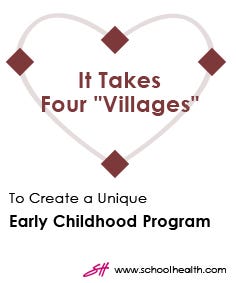- Home
- It Takes Four "Villages" To Create a Unique Early Childhood Program
- 866-323-5465
- Mon-Fri, 7am-5pm CST
- Need Help?
It Takes Four "Villages" To Create a Unique Early Childhood Program

In between the rolling hills of Barrington, Ill., sits four "villages" designed for early learning. Each village nurtures a child's curiosity for learning, builds coordination, and encourages social interaction and positive social behavior. But most importantly, according to principal Barbara Romano, in these "villages" children with special needs have the opportunity learn and succeed, just like everyone else.
The Barrington Early Learning Center serves 267 students from 11 communities. The center is composed of teachers who are certified in early childhood special education. Specialists on the team include language pathologists, social workers, psychologists, occupational therapists, school nurses, and physical therapists. English Language Learner instructors are also available when English is a second language. The specialists work closely with classroom teachers to create a structured schedule and curriculum, which are essential for kids who are unable to handle disruptions with daily schedules.
Ms. Romano has been an early childhood special education instructor for more than 25 years and feels truly fortunate to be serving as the center's principal. "Special education is a passion of mine," said Ms. Romano. "I want families to embrace their children for who they are to love them and help them work up to their potential."
According to Ms. Romano, nearly half of the center's student population has a special need. Some have mild speech or motor delays, others may have light or sound sensitivities, and few have significant physical challenges. "This center combines many of the best practices we know in early childhood education to create an environment that nurtures and educates not just the children who are developing normally, but also those with special needs," she said.
For example, the walls and furniture are neutral in color to provide a calming environment. "Research shows that earthy tones are better for kids with attention deficit issues or for kids with immature neurological systems," noted Ms. Romano.
 Barrington Early Learning Center
Barrington Early Learning CenterThe classroom lighting system is designed to bounce off the ceilings and softened for students with light sensitivities. A therapeutic swing is available to calm the nervous system and promote receptivity to learning. The toilets, while tiny in size, also have grooves around the seat to help children unable to balance themselves sit without falling off.
The windows are designed to be large and low to allow plenty of natural lighting and a view of the outdoors. "We know that natural lighting and nature views are calming and help kids focus better." Sinks are available for children in wheelchairs so they can wash their hands without help. Even the outdoor playground is designed for young children who are still developing their motor skills.
Each of the four "villages" (each identified by the color of a season) in the Early Learning Center has four classrooms and a "town hall." The town hall is where the children gather to meet up, sing together, and learn from each other.
"We believe that it does take a village to raise a child," said Ms. Romano. "Not only can kids learn from us, but they can also learn from each other. Because they get to interact with other kids in the village, they begin to realize that while they may look different, they are all the same."
To create this one of a kind Early Learning Center required the dedication and commitment of not just the school board, but also the guidance of renowned early childhood expert, Judy Harris Helm, Ed.D. Dr. Helm has worked with the State Boars ISBE as an administrator for Peoria Public Schools. She works closely with early childhood schools in integrating research and new methods into the environment, curriculum, and teacher training.
"Our center is structured from the children's point of view, which helps them learn and develop better," added Ms. Romano. "More early childhood schools will move toward this model because communities are now acknowledging the benefit of early intervention. We are helping children learn new skills and become more independent. They can become productive members of society, and it all starts here, in early childhood programs like ours."
 School Health would like to thank Barbara Romano, Barrington Early Learning Center Principal for her contribution to our blog.
School Health would like to thank Barbara Romano, Barrington Early Learning Center Principal for her contribution to our blog.
